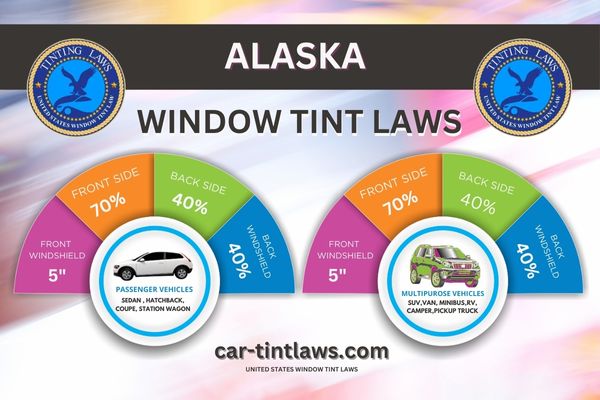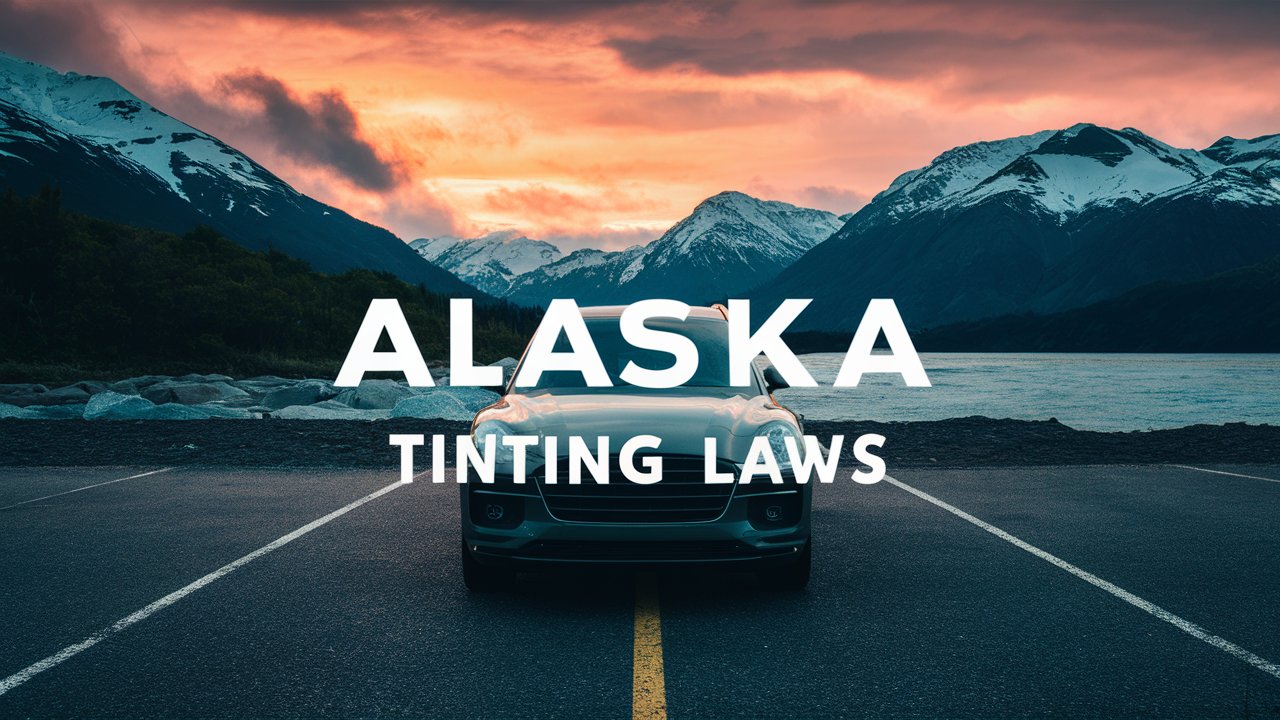When you’re driving, when you’re parked, and when you’re on the move in Alaska, understanding window tinting laws can make a significant difference.
You might be curious about how much tint is allowed on your windshield, or maybe you’re wondering if there are specific rules for SUVs and vans.
The state’s regulations are detailed and specific, covering everything from light transmission levels to reflective tinting.
With potential fines and enforcement measures at stake, it’s essential to know what’s permissible and what’s not.
So, what do you need to stay compliant and avoid penalties?
Window Tint Darkness in Alaska
When considering window tint darkness for your vehicle in Alaska, it’s important to understand the specific requirements for different types of vehicles.
For sedans, the law mandates that front side windows must allow at least 70% light transmittance, while rear windows can go down to 40%.
SUVs and vans have similar regulations, ensuring that the tint levels provide adequate visibility and comply with state standards.
Tint darkness for sedans:
- Windshield: Brow tinting on the front windshield is permissible, provided it stays within the specified limits.
- Front Side windows: Must allow at least 70% of light in.
- Back Side windows: Must allow at least 70% of light in.
- Rear Window: Must allow at least 40% of light in.
Tint darkness for SUV and Vans:
- Windshield: Non-reflective tint is allowed on the top 6 inches of the windshield.
- Front Side windows: Must allow more than 70% of light in.
- Back Side windows: Must allow more than 40% of light in.
- Rear window: Any shade can be used
Window Tint Reflection in Alaska
When considering tint reflection in Alaska, it’s important to know the rules differ slightly based on the type of vehicle you drive.
For sedans, any tint that creates a mirrored or reflective effect is strictly prohibited, ensuring safety and minimizing distractions.
SUVs and vans must also adhere to this rule, maintaining a non-reflective surface on all tinted windows.
Tint reflection for sedans:
- Front Side windows: Reflective tinting materials on sedans in Alaska must not exceed 20% reflectivity.
- Back Side windows: Reflective tinting materials on sedans in Alaska must not exceed 20% reflectivity.
Tint reflection for SUV and vans:
- Front Side windows: Reflective quality must not cause excessive glare or hinder visibility.
- Back Side windows: Reflective quality must not cause excessive glare or hinder visibility.
- Front Windshield: Reflective quality must not impede visibility for the driver.
- Back Windshield: Reflective quality must not impede visibility for the driver.
- Side Mirrors: Reflective quality should not distort rearview vision.
- Rearview Mirror: Reflective quality should not distort rearview vision.
Other Alaska window tint rules and regulations
- Side Mirrors: No restrictions.
- Restricted Colors: In Alaska, all tint colors are permitted.
- Certificates: Manufacturers of film need to certify the film they sell in the state. Ask your dealer if they are using certified film.
- Stickers: The sticker/label of compliance to identify legal tinting is required between the film & glass on each tinted window.
- Medical Exceptions: Alaska permits medical exemptions for special tint. For more details about the specific terms of the exemption, consult AK state law.
- Penalties: Maximum $100 and/or 10 days in prison for first conviction. Second conviction within a year max $200 and/or 30 days in jail. Third and subsequent offense within a year $500 and/or up to 3 months in prison.

Medical Exemptions for Window Tint Rules in Alaska
Occasionally, Alaskan drivers with certain medical conditions can obtain exemptions from standard window tinting laws, provided they carry annual certification from a licensed physician.
If you have a valid medical reason, your physician can issue a certification that allows for less light transmittance than typically permitted under Alaska’s tint regulations.
This certification must be carried in your vehicle at all times to comply with the law.
To qualify for a medical exemption, the tinting materials used on your windows must adhere to specific tint colors approved by the state.
These include green, gray, bronze, or neutral smoke. It’s important to make sure that the light transmittance of your windows is measured accurately using a certified device.
This will help to verify that your tint meets the requirements outlined in your medical exemption.
Alaska Window Tint Ticket Cost
In Alaska, getting caught with illegal window tint can result in a $300 ticket plus a $10 surcharge for non-corrected violations.
The Anchorage Police Department enforces municipal ordinances regarding window tinting, making sure that all vehicles comply with state regulations.
If you’re found in violation, you won’t receive points on your driving record, but the fines and penalties can still be a hassle.
To avoid these fines, you have the option to correct the violation.
Compliance verification is done at the Anchorage Police Department Headquarters, where they’ll use a tint meter to measure the light transmission through your windows.
If your tint meets the legal requirements, you can avoid paying the hefty fines.
It’s crucial to be aware of these regulations to evade unnecessary penalties.
The Anchorage Police Department is vigilant in maintaining these standards to promote safety and visibility on the roads.
By understanding and adhering to these rules, you can avoid the steep window tint ticket cost and keep your driving record clean.
Being proactive about compliance can save you from costly fines and maintain your peace of mind on Alaska’s roads.
Alaska DMV Contact Information
If you have questions about Alaska’s window tinting laws, you can contact the Alaska DMV at (907) 269-5551, visit their website, or go to one of their office locations.
They can provide detailed information on permissible tint percentages, exemptions, and medical certifications.
The DMV’s operating hours are listed on their website, along with additional contact methods for your convenience.
DMV Office Locations
Alaska DMV offices across the state provide important services like driver’s license renewals, vehicle registrations, and title transfers.
These offices are strategically located to make sure that residents throughout Alaska can access the necessary vehicle services without undue travel.
You can visit these DMV office locations to handle various tasks related to your vehicles, such as obtaining or renewing driver’s licenses, registering vehicles, and transferring titles.
Additionally, these offices provide information on vehicle inspections and emissions testing, guaranteeing your vehicle meets state regulations.
When planning a visit, it’s vital to check the specific services offered at each location since they might vary.
For instance, some offices may not conduct emissions testing or vehicle inspections.
The official Alaska DMV website provides contact information for each office, allowing you to confirm the availability of services before making the trip.
This can save you time and make sure that your visit is productive. By utilizing these resources, you can stay compliant with Alaska’s vehicle laws and keep your documents up to date.
Always refer to the contact information provided online to connect with the appropriate DMV office for your needs.
Contact Methods Available
You can easily get in touch with the Alaska DMV through various methods to inquire about window tinting laws.
To speak directly with a representative, you can call the Alaska DMV at 907-269-5551.
This phone line is specifically set up to handle inquiries about window tinting regulations and requirements, making sure you get accurate information quickly.
For more detailed information, you can visit the Alaska DMV website, which provides extensive details on window tint regulations and requirements.
If you have specific questions that need further clarification, emailing the Alaska DMV at [email protected] is another effective contact method.
This allows you to receive written responses that you can refer back to later.
Additionally, for in-person assistance, you can reach out to local DMV offices in Alaska.
Speaking directly with DMV staff can provide immediate answers to your window tinting inquiries.
Lastly, don’t forget to follow the Alaska DMV on social media platforms.
They frequently post updates and announcements related to window tinting laws, keeping you informed about any changes or new requirements.
These contact methods make sure you have all the necessary information to comply with Alaska’s window tinting laws.
Operating Hours Information
Wondering when you can visit the DMV to inquire about window tinting laws? The Alaska DMV‘s working hours are typically Monday to Friday from 8:00 AM to 4:30 PM.
However, some DMV offices may have extended hours or specific days dedicated to certain services.
To make sure you have the most accurate and up-to-date information, it’s best to contact the Alaska DMV directly.
If you prefer not to visit in person, the DMV offers online services available 24/7 for certain transactions and inquiries.
This can be particularly useful if you need to gather information outside regular working hours.
When planning your visit, be sure to bring all necessary documents and information to streamline your experience.
For specific services, such as inquiries about window tinting laws, it’s always wise to confirm the visiting requirements beforehand.
This can help you avoid any unnecessary trips and make certain you have everything you need.
You can find contact information for your local DMV office on the Alaska DMV’s official website.
Remember, staying informed with accurate information and being prepared with the necessary documents can make your visit much smoother.
References
Alaska Statutes Title 1 Chapter 04 Sec. 223 – Tinted vehicle windows
Municipality of Anchorage – Traffic, Vehicle Equipment FAQ – Tinted Windows
Frequently Asked Questions
What Is the Darkest Legal Tint in Alaska?
You’re wondering about the darkest legal tint in Alaska? Well, for rear windows, it’s 40% light transmittance.
This balances sunlight protection, privacy concerns, heat reduction, UV ray blockage, car aesthetics, road visibility, safety measures, and legal compliance.
What Is the Max Window Tint in Alaska?
What’s the max window tint in Alaska, you ask? You’re allowed 70% tint percentage for front windows and 40% for rear ones.
This guarantees UV protection, road visibility, heat reduction, privacy, and meets safety regulations.
How to Get Medical Exemption for Window Tint in Alaska?
To get a medical exemption for window tint, obtain medical documentation, including a doctor’s note, detailing your vision impairment or eye sensitivity.
Confirm it meets state regulations on tint percentage and legal requirements for medical necessity and condition.
What Is the Darkest Legal Car Tint?
The darkest legal car tint lets 40% light transmission through rear windows, balancing privacy benefits, UV protection, and heat reduction.
While enhancing visual aesthetics, it’s essential for safety concerns. Proper installation and maintenance guarantee compliance with legal limits.
Conclusion
In Alaska, understanding and adhering to window tinting laws is essential for your safety and legal compliance.
Whether you’re driving a sedan, SUV, or van, knowing the permissible levels of light transmission and reflection will help you avoid fines and enforcement measures.
If you require medical exemptions, make sure you have certified documentation from a licensed physician.
Always stay informed and compliant with the state’s regulations to guarantee a smooth and lawful driving experience.
